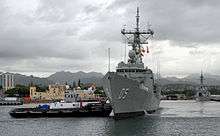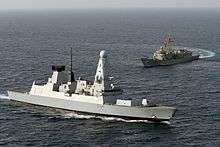HMAS Melbourne (FFG 05)
 HMAS Melbourne in 2018 | |
| History | |
|---|---|
| Namesake: | City of Melbourne |
| Ordered: | 1980 |
| Builder: | Australian Marine Engineering Consolidated |
| Laid down: | 12 July 1985 |
| Launched: | 5 May 1989 |
| Commissioned: | 15 February 1992 |
| Identification: | MMSI number: 503107000 |
| Motto: | "Vires Acquirit Eundo" (She gathers strength as she goes) |
| Honours and awards: |
|
| Status: | Active as of 2018 |
| General characteristics | |
| Class and type: | Adelaide-class guided missile frigate |
| Displacement: | 4,100 tons |
| Length: | 138.1 m (453 ft) overall |
| Beam: | 13.7 m (45 ft) |
| Draught: | 7.5 m (25 ft) |
| Propulsion: |
|
| Speed: | 29 knots (54 km/h; 33 mph) |
| Range: | 4,500 nautical miles (8,300 km; 5,200 mi) at 20 knots (37 km/h; 23 mph) |
| Complement: | 184 (including 15 officers, not including aircrew) |
| Sensors and processing systems: |
|
| Armament: |
|
| Aircraft carried: | 2 helicopters |
HMAS Melbourne (FFG 05) is an Adelaide-class guided-missile frigate of the Royal Australian Navy (RAN). The ship entered service in 1992. Melbourne has been deployed to the Persian Gulf on several occasions, and served as part of the INTERFET peacekeeping taskforce in 2000. The ship is operational as of 2017.
Design and construction
Following the cancellation of the Australian light destroyer project in 1973, the British Type 42 destroyer and the American Oliver Hazard Perry-class frigate were identified as alternatives to replace the cancelled light destroyers and the Daring-class destroyers.[1] Although the Oliver Hazard Perry class was still at the design stage, the difficulty of fitting the Type 42 with the SM-1 missile, and the success of the Perth-class acquisition (a derivative of the American Charles F. Adams-class destroyer) compared to equivalent British designs led the Australian government to approve the purchase of two US-built Oliver Hazard Perry-class frigates in 1976.[1][2] A third was ordered in 1977, followed by a fourth, with all four ships integrated into the USN's shipbuilding program.[3][4][5] A further two ships (including Melbourne) were ordered in 1980, and were constructed in Australia.[4][5]

As designed, the ship had a full load displacement of 4,100 tons, a length overall of 138.1 metres (453 ft), a beam of 13.7 metres (45 ft),[6] and a draught of 6.7 metres (22 ft).[7][8] Propulsion machinery consists of two General Electric LM2500 gas turbines, which provide a combined 41,000 horsepower (31,000 kW) to the single propeller shaft.[8] Top speed is 29 knots (54 km/h; 33 mph), with a range of 4,500 nautical miles (8,300 km; 5,200 mi) at 20 knots (37 km/h; 23 mph).[8] Two 650-horsepower (480 kW) electric auxiliary propulsors are used for close manoeuvring, with a top speed of 4 knots (7.4 km/h; 4.6 mph).[8] Standard ship's company is 184, including 15 officers, but excluding the flight crew for the embarked helicopters.[8]
Original armament for the ship consisted of a Mark 13 missile launcher configured to fire RIM-66 Standard and RGM-84 Harpoon missiles, supplemented by an OTO Melara 76-millimetre (3.0 in) gun and a Vulcan Phalanx point-defence system.[7][8] As part of the mid-2000s FFG Upgrade Project, an eight-cell Mark 41 Vertical Launch System was fitted, with a payload of RIM-162 Evolved Sea Sparrow missiles.[9] For anti-submarine warfare, two Mark 32 torpedo tube sets are fitted; originally firing the Mark 44 torpedo, the Adelaides later carried the Mark 46, then the MU90 Impact following the FFG Upgrade.[8][10] Up to six 12.7-millimetre (0.50 in) machine guns can be carried for close-in defence, and since 2005, two M2HB .50 calibre machine guns in Mini Typhoon mounts have been installed when needed for Persian Gulf deployments.[8][11] The sensor suite includes an AN/SPS-49 air search radar, AN/SPS-55 surface search and navigation radar, SPG-60 fire control radar connected to a Mark 92 fire control system, and a Mulloka hull-mounted sonar.[8] Two helicopters can be embarked: either two S-70B Seahawk or one Seahawk and one AS350B Squirrel.[8]
The ship was laid down by AMECON at Williamstown, Victoria on 12 July 1985.[12] She was launched on 5 May 1989.[12] Melbourne was commissioned into the RAN on 15 February 1992.[12]
Operational history


In 1996, the frigate was deployed to the Persian Gulf.
Melbourne was deployed to East Timor as part of the Australian-led INTERFET peacekeeping taskforce from 20 January to 23 February 2000.[13]
In 2002, Melbourne participated in the third rotation of RAN ships to the Persian Gulf as part of Operation Slipper, where she enforced United Nations sanctions against Iraq.[12] In 2003, the ship returned to Iraqi waters in support of Operation Catalyst, protecting Iraqi territorial waters following Operation Iraqi Freedom.
Following an overhaul of the RAN battle honours system, completed in March 2010, Melbourne was awarded the honours "East Timor 2000" and "Persian Gulf 2002".[14][15]
On 16 August 2010, Melbourne was deployed to the Middle East for the third time, again as part of Operation Slipper.[16] During the six-month deployment, the frigate participated in anti-piracy operations in the Arabian Sea and responded to 14 distress calls from merchant vessels, including the British chemical tanker MV CPO China on 3 January 2011.[16][17] Although it took six hours for Melbourne to close with CPO China, the merchant ship's crew secured themselves in the citadel, and the pirates retreated when the frigate and her Seahawk helicopter arrived.[17][18] Melbourne returned to Sydney on 18 February 2011.[16]
Between 5 and 7 February 2014, while deployed off Tanzania, Melbourne seized and destroyed 575 kilograms (1,268 lb) of heroin from smuggling vessels.[19] On 18 February, while operating off Oman's Masirah Island, Melbourne and the Pakistani frigate PNS Alamgir intercepted and boarded a dhow found to be carrying 1,951 kilograms (4,301 lb) of cannabis resin.[20]
Citations
- 1 2 Jones, in Stevens, The Royal Australian Navy, p. 220
- ↑ Frame, Pacific Partners, pp. 102, 162
- ↑ Frame, Pacific Partners, p. 162
- 1 2 MacDougall, Australians at war, p. 345
- 1 2 Hooton, Perking-up the Perry class
- ↑ Oliver Hazard Perry-class frigate
- 1 2 Moore (ed.), Jane's Fighting Ships 1977-78 , p. 25
- 1 2 3 4 5 6 7 8 9 10 Sharpe (ed.), Jane's Fighting Ships 1998-99, p. 26
- ↑ Australia's Hazard(ous) Frigate Upgrade, in Defense Industry Daily
- ↑ Fish & Grevatt, Australia's HMAS Toowoomba test fires MU90 torpedo
- ↑ Scott, Enhanced small-calibre systems offer shipborne stopping power
- 1 2 3 4 Royal Australian Navy, HMAS Melbourne (III)
- ↑ Stevens, Strength Through Diversity, p. 15
- ↑ "Navy Marks 109th Birthday With Historic Changes To Battle Honours". Royal Australian Navy. 1 March 2010. Archived from the original on 13 June 2011. Retrieved 23 December 2012.
- ↑ "Royal Australian Navy Ship/Unit Battle Honours" (PDF). Royal Australian Navy. 1 March 2010. Archived from the original (PDF) on 14 June 2011. Retrieved 23 December 2012.
- 1 2 3 "Pirate Buster HMAS Melbourne coming home". Royal Australian Navy. 17 February 2011. Archived from the original on 6 April 2011. Retrieved 5 April 2011.
- 1 2 "HMAS Melbourne disrupts pirate attack in Arabian Sea" (Press release). Department of Defence (Australia). 5 January 2011. Retrieved 5 April 2011.
- ↑ Australian Associated Press (6 January 2011). "Aussie warship thwarts pirate attack". The Sydney Morning Herald (smh.com.au). Retrieved 5 April 2011.
- ↑ Australian Associated Press (10 February 2014). "Second major heroin bust for Australian Navy in a week". The Brisbane Times. Retrieved 13 February 2014.
- ↑ Rejimon, K (19 February 2014). "$102m drugs seized from dhow off Oman coast". Times of Oman. Retrieved 19 February 2014.
References
- Books
- Frame, Tom (1992). Pacific Partners: a history of Australian-American naval relations. Rydalmere, NSW: Hodder & Stoughton. ISBN 0-340-56685-X. OCLC 27433673.
- Jones, Peter (2001). "1972–1983: Towards Self-Reliance". In Stevens, David. The Royal Australian Navy. The Australian Centenary History of Defence (vol III). South Melbourne, VIC: Oxford University Press. ISBN 0-19-555542-2. OCLC 50418095.
- MacDougall, Anthony Keith (2002) [1991]. Australians at war: a pictorial history (2nd (revised and expanded) ed.). Noble Park, Vic: The Five Mile Press. ISBN 1-86503-865-2. OCLC 260099887.
- Moore, John, ed. (1977). Jane's Fighting Ships 1977-78. Jane's Fighting Ships (80th ed.). London: Jane's Yearbooks. ISBN 0531032779. OCLC 18207174.
- Sharpe, Richard, ed. (1998). Jane's Fighting Ships 1998-99. Jane's Fighting Ships (101st ed.). Coulsdon, Surrey: Jane's Information Group. ISBN 071061795X. OCLC 39372676.
- Stevens, David (2007). Strength Through Diversity: The combined naval role in Operation Stabilise (PDF). Working Papers. 20. Canberra: Sea Power Centre - Australia. ISBN 978-0-642-29676-4. ISSN 1834-7231. Archived from the original (PDF) on 10 September 2012. Retrieved 6 September 2010.
- Journal articles
- Fish, Tim; Grevatt, Jon (24 June 2008). "Australia's HMAS Toowoomba test fires MU90 torpedo". Jane's Navy International. Jane's Information Group.
- Hooton, E.R. (1 December 1996). "Perking-up the Perry class". Jane's International Defence Review. Jane's Information Group. 9 (9).
- Scott, Richard (12 December 2007). "Enhanced small-calibre systems offer shipborne stopping power". International Defence Review. Jane's Information Group.
- Websites
- "Australia's Hazard(ous) Frigate Upgrade". Defense Industry Daily. Watershed Publishing. 14 January 2008. Retrieved 21 April 2008.
- "HMAS Melbourne (III)". Royal Australian Navy. Retrieved 24 March 2015.
External links
![]()